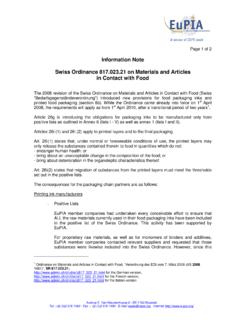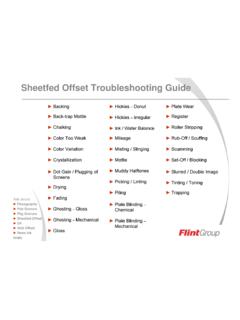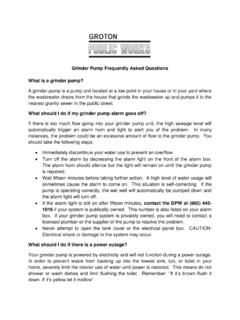Transcription of Flexography Troubleshooting Guide - Αρχική
1 Flexography Publication Gravure Sheetfed Offset UV Web Offset News Ink HOMEF lexography Troubleshooting Guide Adhesion Bleed Blushing (Hazing, Fogging) Color Too Strong Color Variations Among Same Color Jobs Being Run In A Plant Dirty Printing Excessive Ink Consumption Fill-in of Reverses and Type Float on Ink Foaming Ghosting Halo Around Print Kick-out Mottle Pinholes or Fisheyes Screening Set-off and/or Blocking Settling of Ink Sheet Feeding Problem Smearing Striations Tracking Trapping Weak Color Flexography Publication Gravure Sheetfed Offset UV Web Offset News Ink HOMEF lexography Troubleshooting GuideCause:1. Viscosity too high2. Viscosity too low3. Ink surface tension too high4.
2 Incorrect ink system for substrate5. Poor film treatment6. Ink drying too slow7. Substrate surface contamination8. Insufficient web temperatureSolution:1. Reduce viscosity consistent with acceptable printability2. Add virgin ink to fountain3. Consult your technical sales representative4. Ensure that the correct ink for the substrate is being used5. Check surface of film for adequate treatment; treat in-line, if possible6. Check driers for heat and airflow; consult your ink manufacturerSolvent Flexo: Reduce with faster solvent blend7. Check with film supplier as to advisability of applying a primer before printing, use in-line treater8. Increase temperature settings of driers, check drier balanceAdhesionProblem:Ink flakes off substrate, comes off when crinkled, or is removed easily in tape test.
3 Flexography Publication Gravure Sheetfed Offset UV Web Offset News Ink HOMEF lexography Troubleshooting GuideCause:1. Improper pigment use in ink formulation2. Coating or adhesive may be rewetting the dried inkSolution:1. Consult your ink manufacturer to reformulate using resistant pigment2. Consult your ink manufacturer to reformulate using resistant pigmentBleed Problem:Color spreads into subsequently applied coating or adhesive. Flexography Publication Gravure Sheetfed Offset UV Web Offset News Ink HOMEF lexography Troubleshooting GuideCause:1. Solvent Flexo: High humidity causing excess moisture build-up in ink2. Solvent Flexo: Moisture condensation on surface of drying inkSolution:1.
4 Solvent Flexo: Consult your ink manufacturer for properly balanced solvent blend for specific ink and printing conditions2. Solvent Flexo: Use less hygroscopic solvent blend for ink reduction; coordinate with your ink manufacturerBlushing (Hazing, Fogging)Problem:Milky, foggy or matte appearance in an ink or coating. Flexography Publication Gravure Sheetfed Offset UV Web Offset News Ink HOMEF lexography Troubleshooting GuideCause:1. Solvent Flexo: Ink viscosity too high Water Flexo: Ink pH too high2. Ink pigmentation too high3. Inappropriate anilox roll; cell volume too great or cell count too low4. Inadequate pressure setting on impression roll5. Plate and/or ink metering roll durometer too low 6.
5 Inadequate impression on doctor bladeSolution:1. Solvent Flexo: Reduce viscosity to proper level with recommended solvent blendWater Flexo: Check and adjust pH then reduce viscosity to proper level2. Reduce ink colorant strength with balanced extender3. Replace anilox roller with one of higher line count and/or lower volume capacity4. Adjust impression for optimum printability5. Consult plate and/or roller manufacturer6. Adjust doctor blade to recommended pressureColor Too StrongProblem:Visual color different from standard. Flexography Publication Gravure Sheetfed Offset UV Web Offset News Ink HOMEF lexography Troubleshooting GuideCause:1. Poor viscosity controlWater Flexo: Lack of pH control2.
6 Variation in substrate porosity or surface treatment3. Previously used ink4. Inadequate amount of ink in fountain or doctor blade chamber5. Different suppliers of same color6. Variation in ink batches7. Non-standard process designSolution:1. Establish set procedures for viscosity controlWater Flexo: Maintain proper pH2. Consult with ink and substrate manufacturers for proper measures to be taken3. Replace or add virgin ink4. Add ink to fountain or ensure adequate ink pressure into enclosed doctor blade assembly5. Run only one supplier s ink on a given color6. Consult your ink manufacturer7. Inks must be modified to matched print station; recommend match visual standard on-siteColor Variations Among Same Color Jobs Being Run in a Plant Flexography Publication Gravure Sheetfed Offset UV Web Offset News Ink HOMEF lexography Troubleshooting GuideCause:1.
7 Excess ink being applied to plate2. Excess impression between plate and substrate3. Ink viscosity too high4. Accumulation of paper dust (lint)5. Ink drying too fast6. Water Flexo: Ink pH too low7. Excessive anilox volume8. Excess anilox impression9. Plate swell caused by use of materials not compatible with printing platesSolution:1. Adjust anilox/fountain roller impression; adjust doctor blade pressure2. Reduce to kiss impression for type and minimize impression consistent with acceptable printability for reverses3. Adjust to lowest viscosity consistent with acceptable printability4. Improve housekeeping, vacuum paper dust and filter ink5. Check air flow at between-deck driers; consult your technical service representativeSolvent Flexo: Use slower solvent blend to reduce ink6.
8 Water Flexo: Raise pH as instructed to by ink manufacturer7. Use lower volume anilox8. Back off impression of anilox to plate9. Confer with plate and ink suppliersDirty PrintingProblem:Fuzzy extensions of image into non-image area. Impression increase or change in plate durometerduring run. Recovers when taken off press; sometimes results in cracks in plate during storage. Flexography Publication Gravure Sheetfed Offset UV Web Offset News Ink HOMEF lexography Troubleshooting GuideCause:1. Ink viscosity too high2. Ink color acceptable, but stronger than standard3. Weak ink4. Excessive anilox volume5. 2 Roll: Soft metering roller6. Excess loss on start up or shutdownSolution:1.
9 Reduce ink to lowest viscosity consistent with acceptable printability2. Use balanced extender to weaken color to the middle of the acceptable range3. Check ink for strength vs. original standard4. Finer/shallower anilox5. Check durometer; extend or reduce ink6. Additional care in ink handling; can be due to large amount of ink required for inking stationExcessive Ink ConsumptionProblem:Too few impressions per pound of ink. Flexography Publication Gravure Sheetfed Offset UV Web Offset News Ink HOMEF lexography Troubleshooting GuideCause:1. Excess ink being applied to plate2. Excess impression between plate and substrate3. Ink viscosity too high4. Accumulation of paper dust (lint)5.
10 Ink drying too fast6. Water Flexo: Ink pH too low7. Excessive anilox volumeSolution:1. Adjust anilox/fountain roller impression; adjust doctor blade pressure2. Reduce to kiss impression for type and minimize impression consistent with acceptable printability for reverses3. Adjust to lowest viscosity consistent with acceptable printability4. Improve housekeeping, vacuum paper dust and filter ink5. Check air flow at between-deck driers. Consult your ink manufacturerSolvent Flexo: Use slower solvent blend to reduce ink6. Water Flexo: Raise pH as instructed by ink manufacturer7. Use lower volume aniloxFill-in of Reverses and TypeProblem:Ink bridges across small print and non-printing gaps in design.











